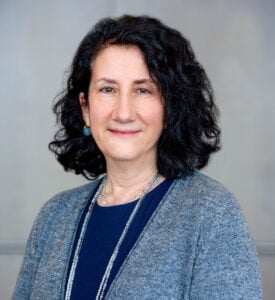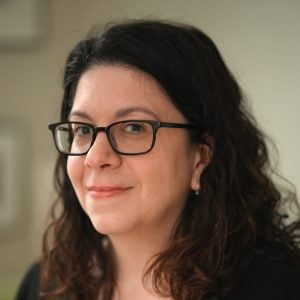In the latest interview for our Admissions Director Q&A series, the Assistant Dean of Admissions at the MIT Sloan School of Management, Dawna Levenson, returns to delve into all things MBA admissions.
As the leader of the admissions team, Dawna oversees all recruiting, evaluation, conversion, and marketing activities in support of the MBA, Sloan Fellows MBA, Master of Finance (MFin), Master of Business Analytics (MBAn), MBA Early Admission, and Master of Science in Management Studies (MSMS) programs. Prior to this role, Dawna was the Director of Admissions for five years and the Associate Director for MFin Admissions for one year. Even before joining MIT Sloan full-time, Dawna worked closely with the Admissions Office since 2007, reading MBA applications. Prior to MIT, Levenson was a partner at Accenture, where she spent 18 years. She holds undergraduate and graduate degrees in Management Science from MIT.
Read on for her insights into the MIT Sloan MBA program, what to expect in admissions this year and more.

Clear Admit: What is the one aspect of your program that you wish applicants knew more about?
Dawna Levenson: We’ve been doing a lot of work around impact investing throughout the pandemic and plan to give it more visibility in the next coming year or so. When people think about going to business school for finance, I’m pretty sure MIT isn’t at the top of their lists. But when they come here, they’re always amazed at the work our faculty are doing related to eco-finance. Investing for good has really taken a life of its own, and this is an area that many of our applicants are passionate about. So I’d love for people to want to learn more about this.
CA: Walk us through the life of an application in your office from an operational standpoint. What happens between the time an applicant clicks “submit” and the time the committee offers a final decision?
DL: We have three application deadlines for the MBA application. We don’t start to look at applications until the day after the deadline. So while we encourage you to apply as soon as you can, applying today versus on our application deadline date isn’t really going to make a difference. After an application deadline has passed, we review all of the submitted applications.
We also have a core group of trained readers who read files and complete a scorecard with a recommendation to Interview or Reject an applicant. In many cases, an application is read multiple times before a decision is made to invite for an interview, WL without an interview, or reject. An interview is by invitation only and a required next step in the process.
Interviewees are asked to submit two additional pieces of information 24 hours prior to the interview. One of those is a written essay that signals the importance of our mission statement, as well as diversity within our community. It asks you to share a time when you contributed to the diversity of an organization or a group. The second is a data visualization slide that has meaning to you. This could be a slide you created yourself or something that you saw online or in an advertisement that really resonates with you. We will ask you to explain what the data visualization is telling us and why it is important to you.
After all interviews for a given round are conducted, the admissions committee will meet over the course of a week to decide who we will admit, waitlist, and reject. Like our readers, interviewers are required to complete a scorecard that includes a recommendation to Admit, Discuss, or Reject a candidate.
CA: How does your team approach the essay portion of the application specifically? What are you looking for as you read an essay? Are there common mistakes that applicants should try to avoid? What is one key thing they should keep in mind as they sit down to write?
DL: I suggest that people think about the cover letter, resume, and the video where you’re introducing yourself to your classmates as a package to tell your story. The resume provides your work history, your video shares who you are and what you’re passionate about, and the cover letter pulls it all together and answers ‘Why MIT Sloan.’
CA: Could you tell us about your interview process? Approximately how many applicants do you interview? Who conducts the interview (students, admissions officers, alumni) and what is the nature of the interview (resume-based, application-based, behavioral)? Will your admissions interviews be in-person or virtual for the 2023-2024 admissions season?
DL: In preparation for the MIT admissions interview, we read all components of an application and watch the video essay. That way, we know everything you’ve shared with us up until this point.
The interview will last around 30 minutes, but that is a ballpark estimate. If an interview lasts 25 minutes or 35, that is no indication at all as to whether or not the interviewer liked you or thought that you’d be a good fit. There’s no correlation there.
It starts with introductions. We will be asking you to explain your data visualization and will ask if there’s been any changes since you submitted your application. We then may ask some probing questions regarding academics or gaps in employment that are specific to the application. The bulk of the interview time is spent asking a series of behavioral questions, which will vary. No two people should have this exact same interview experience. You’re not the same person, so there may be more questions to probe on for one than another. So again, people should not compare their interview experience with others. We will then always leave time for the interviewee to ask us questions. I like to think of it more of a conversation than an interview.
Interviews will continue to be via Zoom. They are by invitation only, with a member of our Extended Admissions Committee and a required step in the process.
CA: What is your testing policy? Do you offer exam waivers? Why or why not?
DL: A valid GMAT or GRE score is a required part of our application. Similar to this past year, we will offer waivers (on a case-by-case basis) for applicants who are unable to access a test either in person or online.
CA: Could you tell us about the waitlist? What can waitlisted applicants do to maximize their chances of being accepted to your program? Does your office allow for waitlisted applicants to submit additional materials (e.g. letters of support, job updates, new test scores, etc.)?
DL: We welcome periodic relevant updates from waitlist applicants. We do not meet individually with waitlist candidates (so please do not fly to Cambridge and camp out in the hall outside of our office, hoping for an in-person meeting).
CA: Tell us briefly about two popular courses at your institution.
DL: I would rather not single out any of our classes. They are all taught by world-renowned faculty who are experts in their respective fields. With a one-semester core, our students have 3 semesters to shape their curriculum and have a range of electives to choose from. While an Action Learning Lab class is NOT a degree requirement, many of our students choose to take at least one Action Learning lab class (if students are enrolled in one of our 7 certificates, there may be a lab requirement).
CA: Is there anything else you’d like to highlight about your MBA program or admissions process?
DL: Our Admissions team is here to support candidates throughout the application process. Please do not hesitate to reach out should you have any questions.






